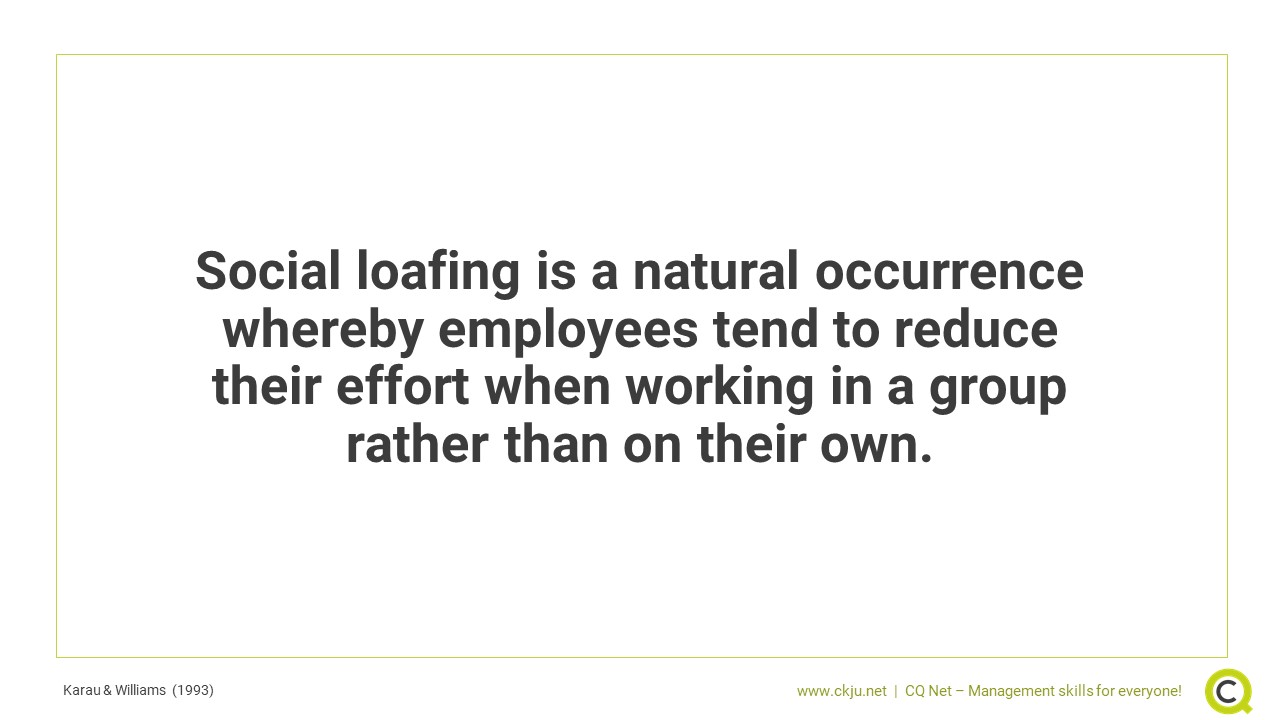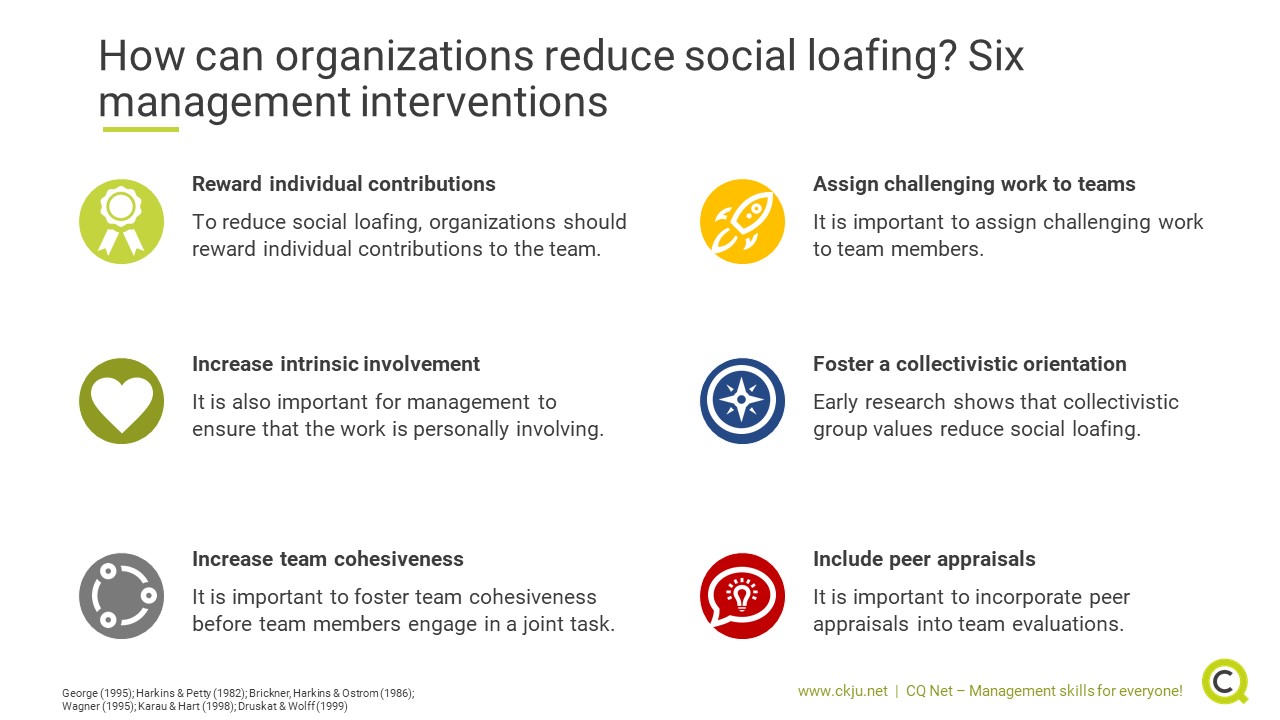- All Management Learning Resources
- Social loafing

Why should you care about Social Loafing in the workplace?
In the last twenty years, organizations have utilized teams because of their effectiveness in producing creative and innovative products. When a team is effective, one of the reasons for this high performance is that team members make a unique and important contribution through their role and the ideas that they produce.
However, there are negative effects that occur from teamwork and one of these is social loafing, which has been extensively researched in the organizational science literature on teams. The concept of Social Loafing became popular when organizations wanted to understand losses in team productivity (Liden, Wayne Jaworski, & Bennett, 2016).
Research scholars determined that social loafing leads to a loss in productivity for organizations so this makes social loafing an important factor to understand for firm effectiveness.
Contents
- Why should you care about Social Loafing in the workplace?
- What is Social Loafing?
- What are the outcomes of Social Loafing in the workplace?
- What promotes Social Loafing?
- How can organizations reduce social loafing?
- Social loafing can be reduced with the right organizational interventions
- Critical appraisal of Social Loafing: Solidity Rating 5
- Key recommendations for professionals
- References and further reading
What is Social Loafing?
Social loafing is a natural occurrence whereby employees tend to reduce their effort when working in a group rather than on their own (Karau & Williams, 1993). Social loafing is a pervasive phenomenon that reduces employee engagement and organizational effectiveness. Both laboratory and field studies have examined the nature of social loafing to determine its antecedents. It is an automatic process that can be conscious or unconscious and is based on the notion that people tend to experience deindividuation when they work in teams as opposed to working alone.
Both laboratory and field studies have examined the nature of social loafing to determine its antecedents. It is an automatic process that can be conscious or unconscious and is based on the notion that people tend to experience deindividuation when they work in teams as opposed to working alone.
Social loafing is due to a decrease in social awareness whereby individuals can resist efforts to fully engage in teamwork. Most researchers believe that the reasons why social loafing occurs is that it is motivational in nature (Karau & Williams, 1993).
What are the outcomes of Social Loafing in the workplace?
Social loafing occurs in the workplace when employees lose their social awareness in a team, compared to working along. Social loafing can have negative consequences for the team and individual team members (Karau & Williams, 1993).
The team dynamics change when social loafing occurs because there is a division between those who contribute and those who do not; this can result in an in-group and an out-group creating tensions between the groups.
Social loafing can also change the effort exerted by individual team members and goals can shift with team members making comparisons between themselves and other team members rather than putting in their best efforts. When an individual feels they are doing most of the work, this can lead to feelings of exploitation and individual team members will reduce their workload.
What promotes Social Loafing?
There are several factors that promote social loafing (Gilovich, Keltener, & Nisbett, 2006).
Social Loafing is more likely to occur in big teams
First, when a team has many team members, social loafing is more likely to occur. Most experts suggest having no more than seven team members in a group. When there are more, there is the likelihood that team members will not participate if they not motivated to work in the team.
Social Loafing is related to a low level of motivation to participate in the team
Second, social loafing becomes exacerbated if there is a low level of motivation to participate in the team. Some employees prefer to work alone and dislike working in a team to complete an assignment; this low level of motivation can increase social loafing and result in poor performance.
Social Loafing is less likely to occur when team member feel their contribution matters
Finally, team members are less likely to exert effort an engage in social loafing if they feel that their contribution does not matter. This could be a matter of good communication rather than an issue with the team or team members itself.
How can organizations reduce social loafing?
Organizational scientists have identified ways to reduce social loafing:
Reward individual contributions to the team
To reduce social loafing, organizations should reward individual contributions to the team. In rewarding team members, management should engage in contingent rewards because this is negatively associated with social loafing (George, 1995).
Team members tend to engage in social loafing when they are rewarded but the rewards are not specifically related to team performance. It is important for management to acknowledge individual contributions to the team (George, 1995).
Assign challenging work to teams
It is important to assign challenging work to team members. Early group research has shown that when tasks are made more difficult or challenging, this reduces social loafing (Harkins & Petty, 1982). This also suggests that it is important to assign difficult and challenging assignments to teams rather than mundane work that can be completed by individuals.
Increase intrinsic involvement
It is also important for management to ensure that the work is personally involving for team members; personal involvement in a task eliminates social loafing mainly because it increases intrinsic motivation (Brickner, Harkins & Ostrom, 1986).
Intrinsic involvement consisting of task significance, task meaningfulness and contribution also reduces social loafing (George, 1992).
Foster a collectivistic orientation within the group
Organizations tend to be more effective when they move away from the individualistic mindset that is inherent within most developed countries such as the United States and foster a collectivistic orientation within the firm. Early research shows that when teams have collectivistic group values, this reduces social loafing and increases cooperation (Wagner, 1995).
Increase team cohesiveness
It is important that management foster team cohesiveness before team members engage in a joint task. Previous research has shown that when dyads agree strongly (high cohesiveness) on a controversial issue, they work just as hard collectively as coactively; dyads who disagreed strongly on an issue tended to engage in more social loafing (Karau & Hart, 1998).
Include peer appraisals
It is important that management ensure to incorporate peer appraisals into team evaluations (Druskat & Wolff, 1999). When peers give each other feedback, this leads to less social loafing.
Moreover, peer feedback can be either negative or positive and still reduces social loafing and has a positive effects on relationships and task focus (Druskat & Wolff, 1999).
Social loafing can be reduced with the right organizational interventions
Despite the negative impact of social loafing on team performance, there is a large body of research showing ways in which it can be reduced. Most of these recommendations can be turned into organizational interventions so that teams can be fully productive.
Critical appraisal of Social Loafing: Solidity Rating 5
Based on the importance of social loafing in the workplace, this dossier is assigned a Level 5 rating (Based on a 1- 5 measurement scale). A level 5 is the highest rating score for a dossier based on the quality of the evidence underlying the concept of social loafing in the workplace. A large body of research has demonstrated the negative impact of social loafing on teams within the workplace showing that it is important for organizations to reduce the effect.
Key recommendations for professionals
- Have small, cohesive teams that are well-motivated to work on a collective project
- Ensure that team members are rewarded for the unique contributions
- Incorporate peer appraisal into team evaluations
- Ensure that teams are assigned engaging tasks that stretch team members
- Ensure teams are provided with resources to help them complete assignments
References and further reading
Brickner, M. A., Harkins, S. G., & Ostrom, T. M. (1986). Effects of personal involvement: Thought-provoking implications for social loafing. Journal of Personality and Social Psychology, 51(4), 763–769.
Druskat, V. U., & Wolff, S. B. (1999). Effects and timing of developmental peer appraisals in self-managing work groups. Journal of Applied Psychology, 84(1), 58–74
George, J. M. (1992). Extrinsic and intrinsic origins of perceived social loafing in organizations. Academy of Management Journal, 35(1), 191–202.
George, J.M. (1995). Asymmetrical effects of rewards and punishments: The case of social loafing. Journal of Occupational and Organizational Psychology, 68, 327–338
Gilovich, T., Keltner, D., & Nisbett, R. E. (2006). Social psychology. W.W. Norton Harkins, S. G., & Petty, R. E. (1982). Effects of task difficulty and task uniqueness on social loafing. Journal of Personality and Social Psychology, 43(6), 1214–1229
Karau, S. J., & Hart, J. W. (1998). Group cohesiveness and social loafing: Effects of a social interaction manipulation on individual motivation within groups. Group Dynamics: Theory, Research, and Practice, 2(3), 185–191.
Karau, S.J & Williams, K.D. (1993). Social loafing: A meta-analytic review and theoretical integration. Journal of Personality and Social Psychology, 65, 681–706
Liden, R. C, Wayne, S.J, Jaworski, R.A, & Bennett, N. (2016). Social Loafing: A Field Investigation. Journal of Management, 30(2), 285–304.
Wagner, J.A. (1995). Studies of individualism-collectivism: Effects of cooperation in groups. Academy of Management Journal, 38, 152-172.
About the Author



